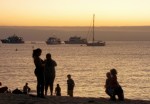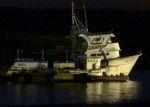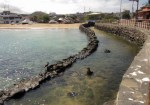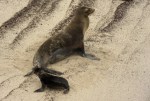Arriving on Isla San Cristóbal I was more than ready for change. My time on Isla Isabela had put me into a dismissive and negative mood and the sooner I was off the island the better. So I went to Isabela’s airport an hour early and met Veronica, another passenger also eager to be gone. She’s a director in the Ministério del Ambiente, kind of a Parks & Recreation Bureau within Ecuador’s central government.
I didn’t know it at the time but she’s a high-level functionary within the workings of the country’s civil service. I found this out later when visiting a Sailors’ Museum and saw a bronze plaque with her name on it. The plaque commemorated the new museum and its major benefactors, with her name prominent on the list.
Anyway, Veronica suggested some things to do while I visited San Cristóbal. One of them was the path that began at the island’s Darwin Interpretation Center and continued to the summit of a hill overlooking the main city of Puerto Baquerizo Moreno. Following that advice I was to take that trail several times during my stay, each time just before sunset. Muchas Gracias, Veronica!
She was very proud of that trail, having recently attended its grand opening after having worked to get it funded and built. She also took my phone number and promised to call and meet while we both visited the island. But this time I was ready for those notorious subjunctive tenses and (rightfully) didn’t expect the call to come. By now I’ve started to recognize “the meeting that will never be.” On the road for less than a year and I’m already making some cultural progress ;}
Who I did meet though were people very different than the folks on Santa Cruz or Isabela. I found people who were not on the make. The people of Santa Cruz, and more specifically Puerto Ayora, are there for your money. They are friendly enough to be sure, but the town and the island by extension, is there to redistribute the wealth (and property if you don’t hold on to your purse) from the visitors of the developed world and relocate this wealth among the people of the developing world. Visitor and resident alike knows this and there’s no misunderstanding. And at a coarser and sleazier level the same is true on Isabela. But San Cristóbal is different.
It also has an airport allowing flights from the mainland, though the traffic is far less than at the main landing strip on Baltra servicing Santa Cruz. And it also has sights and tours to some relatively unique features, like the only natural fresh water source in the Galapagos. What keeps this island different in flavor is the presence of federal offices, a large naval base, and national commercial fishing administration. There are dry-dock facilities, freight-forwarding yards and other trappings of non-tourist related activity. So one’s chances of meeting someone not involved with tourism are far easier on San Cristóbal. No scams for a change, and a welcome one too.
In Puerto Baquerizo Moreno the streets are clean. And the waterfront promenade with its one-way street was named, but what else? Avenida Charles Darwin. All the shop fronts and park benches in the sun and the shade were well-cared for. This port town was neat, proud, and yet still had time to be friendly.
Just outside the Darwin Interpretation Center there is a brand new UNC/Chapel Hill facility housing earth and/or natural sciences graduate students with lecture halls and common areas as well. The architecture blends well with the surrounding structures and land forms. It was the beginning of fall semester and the grad students seemed to be mixing rather smoothly with the local residents. This island is definitely different from the others.
Yet again Janina was right by revealing to me that the people can be every bit as interesting as the animals. I got a first-hand view of her thesis and now am a believer too. People can and do change rapidly in different social structures. They had clearly done so among the inhabited islands of the Galapagos. But do they evolve? Maybe, if they are as adaptable as guppies.
Which brings me to perhaps my biggest failure while visiting the Galapagos: I never visited Floreana, the mystery island. The last, smallest, of the inhabited islands, Floreana boasted a tale of death, perhaps murder and certainly deceit; mistresses and scandal with transformation following hellfire. Being south of the main island group, this outpost holds itself back from the others.
Set completely ablaze by a whaler’s prank in 1819, it is now believed that a number of important and unique species of animals were lost in the conflagration that consumed the entire island. Descendants of the original settlers from early 20th Century still run the single hotel on Floreana. And if I ever return to the Galapagos, I’m going there very early in the trip.
Back on San Cristóbal, one night walking, I encountered a sea lion pup not more than a very few hours old. Cruising along the town’s seawall and encountering herds of sea lions is vaguely reminiscent of San Francisco’s Fisherman’s Wharf. The difference being that the hundreds of sea lions use the beach here, plus the common piers and sidewalks to bask; Watch your Step!!
Barely able to move with most of the umbilicus attached, as was the placenta to the mother, this particular little pup was too weak and still too new to use the flaccid skins that would become flippers. When I returned barely 8 hours later those same flippers had somehow “inflated” and were now able to carry the pups weight as it struggled to find its mother to nurse.
Witnessing both of these sea lion pup events I was accompanied by a recent friend, Michaela. Twenty years my junior, this owner of a German travel agency and I had bumped into each other on 4 islands now, so we ended up wandering the docks and eateries along the waterfront. I was fortunate that Michaela speaks far more English (she’s fluent) than my 4 words of German. We compared notes of our various day tours and she collected the information for her clients back home. My second regret, after Floreana, is that I never directly introduced Janina and Michaela. I’ve made some amends via the computer and I sincerely hope that both of them thrive.
In Puerto Baquerizo Moreno I had my first (and only) lobster in the Galapagos. It was pretty good and pretty cheap. Seafood in the Galapagos is generally a bargain. Along with visiting Floreana, I will spend more time on this island should I get blown back to this part of the world. If I weren’t so fond of Janina and her family on Santa Cruz, I’d fly directly here from Guayaquil. And being retired, I’d happily and easily spend a month in these islands. Now THAT, would be a vacation!
It’s mid-November as I’m writing this and I’m living a comfortable life in Lima; the Galapagos is a long way away. When I consider those various experiences there and the people I met, I think often about how I could improve on my trip. And the most obvious change would incorporate my new love of being aboard a boat. I would root out more day-trip boat tours, or perhaps even a short multi-day cruise. But I wouldn’t learn to SCUBA dive here. These waters are for experienced divers.
The unique life systems that motivated Darwin to devise his theories were themselves the results of unique geologic and geographic conditions found nowhere else on the planet. These islands sit at the collision point of 5 major and 4 minor ocean currents.
From the massive Humboldt Current bringing both cold water and surprisingly cool air temperatures up from the Antarctic, to the nutritionally important Pacific Equatorial Under Current bringing food eastward from the ocean depths to feed the whales, to the Panama Current bringing rain and clear diving waters, these currents form a complex set of powerful forces which endanger the unwary. So learn to dive elsewhere, learn safety and emergency procedures and then you can put the knowledge to good use here.
A day-trip for SCUBA divers will cost somewhere under $200/person. It’s all-inclusive with well maintained equipment, just show up with your bathing suit (and a set of warm, dry clothes). But if you’re like me with size 13 feet, bring your own fins. Each of the populated islands offers day-trips and with some pre-planning before leaving home one can easily dive in almost all of the biomes in the islands.
What about the last-minute cruise packages, said to be possible at amazing discounts? Possibly. But marketing has changed over the last several years. When the Islands started accepting tourists wholesale a generation ago, the park was geared solely for the well-heeled who could afford multi-day cruises aboard all manner of yachts. There were no land-based facilities and the choice was expensive cruises or stay home.
As more travelers visited the islands, the galapagueños rose to the challenge and began offering trips for land-based tourism. Each year saw newer and more extensive and comprehensive ways to experience these islands without committing to an expensive cruise package that virtually dictates every minute of every day. The change in emphasis from cruises (which, to be sure, still exist in a multitude of options) to land-based day trips brought about a corresponding change in what gets flogged to the newer generation of bargain conscious traveler.
Now that all the hip travel guides mention the lure of last-minute cruise deals that is exactly what is (said to be) offered by every business everywhere on the islands. Of course it begs the question: if they are all last minute, how can this be a bargain? I’m still waiting for that answer. The various agencies, sporting goods stores, and shoeshine boys, each of whom offer tickets to everything everywhere network amongst themselves with smartphone apps, so the deals of a decade ago are deals no more.
What this means is that one sees a leveling of pricing that follows the increase in choices. So one now still has the option for a pampered but rather rigid cruise package (which take the traveler to places off-limits to the day-trippers) or a more personalized though still regulated series of land-based 1/2 day and full day tours. As there is some wriggle-room in pricing for the land-based tours, a general homogenization of offerings among vendors markedly dampens opportunities for bargaining. Yet it doesn’t hurt to ask. Hidden treasures exist if you seek them out and you don’t have to pay the asking price.
The Galapagos Islands is an experience every bit as astounding as people say. I barely touched on what is there and how a visitor can see it. I met a Scottish couple in Quito who spent £800 between the 2 of them, for a week. That’s a bit less per day than I spent and one of them had a sea lion come up to him and kiss his GoPro® while snorkeling off Isla Española. I watched it on their computer back at the SAEX Clubhouse.
There are as many ways to visit the Islands as there are visitors. Pick one…
- Aerial View of Puerto Baquerizo Moreno
- Sunset — Puerto Baquerizo Moreno
- Baquerizo Moreno Harbor
- Sunset, La Playa
- Michaela Boerjes
- SS Silver Galapagos
- San Cristoból’s Harbor
- Long-liner Manta
- These Benches are Taken
- Nice Colors
- SS Neptuno
- Sea Lion Nursery
- Downtown Puerto Baquerizo Moreno
- Mother and Day-old Pup
- Avenida Charles Darwin
- Busy Harbor
- Water Taxi



















Love the photos, Karl, and your continuing diary, of course. Take care of yourself. -R
LikeLike
Thanks Roberta and shout-out to Bill! Flying from Quito, I had no idea on my way over that the Galapagos are about something more than the animals. Just had a voice message from Janina on Santa Cruz (the island, not your city). She’s got some big challenges ahead and I’m rooting for her to pull through.
LikeLike
Hi Karl, What an adventure you’re having. I’ve been reading all of your posts with great interest! Happy Thanksgiving and keep well. Aloha, Ann Takahashi
LikeLike